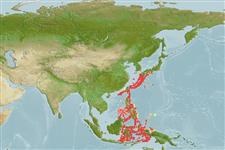Teleostei (teleosts) >
Gadiformes (Cods) >
Macrouridae (Grenadiers or rattails)
Etymology: Ventrifossa: Latin, venter, ventris = belly + Latin, fosa = pit (Ref. 45335).
More on authors: Gilbert & Hubbs.
Environment: milieu / climate zone / depth range / distribution range
Ecology
Marine; bathydemersal; non-migratory; depth range 270 - 700 m (Ref. 1371). Deep-water; 34°N - 8°S, 115°E - 138°E (Ref. 1371)
Western Pacific: southern Japan, Taiwan, Philippines, and parts of Indonesia (Borneo, Halmahera). Slight morphological variation seen in specimens from Japan and Indonesia, but not sufficient to recognize additional taxa.
Size / Weight / Age
Maturity: Lm ? range ? - ? cm
Max length : 34.0 cm TL male/unsexed; (Ref. 1371)
Dorsal spines (total): 2; Anal spines: 0. Scales medium-sized, with slender, sharp, conical slanting spinules arranged in widely divergent V rows or in quincunx pattern. Snout with black margin along its leading edge, extending posteriorly to suborbital shelf but not over supranarial and median nasal ridges.
A benthic species found on the continental slope (Ref. 75154).
Life cycle and mating behavior
Maturities | Reproduction | Spawnings | Egg(s) | Fecundities | Larvae
Cohen, D.M., T. Inada, T. Iwamoto and N. Scialabba, 1990. FAO species catalogue. Vol. 10. Gadiform fishes of the world (Order Gadiformes). An annotated and illustrated catalogue of cods, hakes, grenadiers and other gadiform fishes known to date. FAO Fish. Synop. 125(10). Rome: FAO. 442 p. (Ref. 1371)
IUCN Red List Status (Ref. 130435)
Threat to humans
Harmless
Human uses
Fisheries: minor commercial
Tools
Special reports
Download XML
Internet sources
Estimates based on models
Preferred temperature (Ref.
123201): 8.3 - 13.6, mean 10 °C (based on 96 cells).
Phylogenetic diversity index (Ref.
82804): PD
50 = 0.5000 [Uniqueness, from 0.5 = low to 2.0 = high].
Bayesian length-weight: a=0.00219 (0.00111 - 0.00431), b=3.20 (3.03 - 3.37), in cm total length, based on LWR estimates for this (Sub)family-body shape (Ref.
93245).
Trophic level (Ref.
69278): 3.7 ±0.5 se; based on size and trophs of closest relatives
Resilience (Ref.
120179): Low, minimum population doubling time 4.5 - 14 years (Preliminary K or Fecundity.).
Fishing Vulnerability (Ref.
59153): Low vulnerability (24 of 100).
